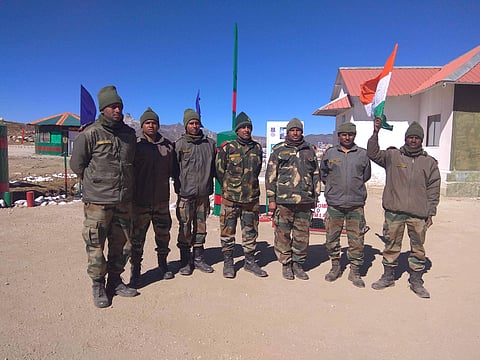

BUMLA PASS (ARUNACHAL PRADESH): “I was in school when Major Sandeep Sir was martyred in Mumbai. I was working in my father’s paper shop. I helped him with collecting old newspapers and later selling them in bulk. I read every bit of news on Major Sandeep Sir. It changed my life. I decided to work hard. My aim was to join the Indian Army,” says a Sepoy, posted at Bumla Pass.
The Sepoy (not naming him) along with other soldiers and officers are part of the 7 Bihar Regiment, now posted at this Sino-India border post, on the Line of Actual Control (LAC).
“Today, I am proud to be in the Indian Army and happy guarding the border. Major Sandeep Sir is my hero. And he will always be,” he adds.
A poster depicting the heroics of martyred NSG commando Major Sandeep Unnikrishnan, who belonged to the 7 Bihar Regiment, welcomes visitors at the entrance of Bumla Pass, which is situated at an altitude of 15,200 feet (4,600 metres) above sea level.
The soldiers manning this sensitive post take pride in being part of the regiment that Major Sandeep once served in.
“He inspires all of us. He is our hero and his brave deeds motivate us all the time,” says a young officer posted here.
Banners highlighting the achievements of each Indian state are put up on both sides of the pathway leading to the LAC.
The soldiers guarding Bumla Pass, braving the hostile weather, are courteous to visitors.
India permits visitors to Bumla Pass with passes issued by the district administration at Tawang. The one-day permits are issued by the Deputy Commissioner’s office in Tawang District and stamped by the Indian Army.
The Indian Army has a decent presence in the area. There are bunkers atop the hills on both sides of the Pass. However, there is no sign of Chinese troops in the vicinity or on their side.
1st China observation post at 4 km from LAC
Approximately 4 km from the Bumla Pass, the People’s Liberation Army has an observation post, visible only through long-range binoculars.
A senior Army official tells this Correspondent that not posting its men on the Bumla Pass, facing the Indian Army, is a strategic decision by the PLA.
“They claim the whole of Arunachal as theirs… and if they put up a post it means they are agreeing to the territorial borders. Bumla is a peaceful post compared to other border posts with China. We have
BPMs (Border Personnel Meetings) regularly,” says the official. China claims Arunachal Pradesh as part of South Tibet.
The Indian side was gearing up for another BPM when this Correspondent visited Bumla Pass.
Chinese radar installation visible
China has a radar installation atop a hill on their side, facing the Indian side.
Two snow-clad peaks are visible on the Chinese side. Beneath lies the famous Tsonajong town, about 40-plus kilometres from Bumla Pass.
“Bumla Pass has its place etched in history. It is through these treacherous tracks that the Dalai Lama entered India, after escaping from Tibet. And during the 1962 war with India, the Chinese troops came in waves through this pass,” says a soldier, explaining the significance of the Pass to visitors.
Visitors pay tribute at ‘Heap of Stones’
The Indian Army bunkers are manned all through the year and act as vital points in spotting and observing any Chinese movement.
An intrusion attempt made by the Chinese barely a month back is fresh in the minds of soldiers.
“The latest intrusion from the Chinese side was on December 28, 2017. Our patrol teams spotted three Chinese nationals carrying out construction work in the Shiyung La area of Upper Siang district. They were pushed beyond and the matter was settled following a Flag Meeting,” says the official.
Visitors were seen placing pebbles on the ‘Heap of Stones’. It is a practice, a symbolic gesture by all those who visit Bumla Pass. An act of gratitude to the mighty Himalayas and a tribute to the Indian Army – both guarding our borders.
(The writer is an independent aerospace and defence journalist and tweets @writetake.)